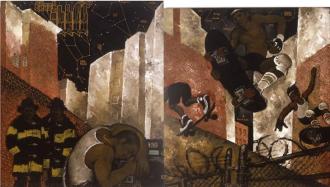
Martin Wong: Human Instamatic
This exhibition surveys the career of Chinese American painter Martin Wong (1946–1999), from his early years painting street portraits in Northern California—where he dubbed himself the “Human Instamatic”—to his role in New York’s gritty downtown art scene in the 1970s and 1980s and his late work in San Francisco before his untimely death from AIDS.
Wong was born in Portland, Oregon, and grew up near San Francisco’s Chinatown. After a year at UC Berkeley, he studied ceramics at Humboldt State University in Eureka. During the 1970s, dividing his time between Eureka and San Francisco, he made scroll poems in idiosyncratic calligraphy and designed sets for psychedelic experimental theater groups the Cockettes and Angels of Light.
Wong’s work changed and blossomed after he moved to New York in 1978. While living openly as a gay man on the Lower East Side, then a poor immigrant neighborhood with a large Latino population, he quickly became part of a burgeoning arts scene. He formed a close relationship with Puerto Rican writer Miguel Piñero, with whom he sometimes collaborated, and befriended several young graffiti artists, collecting their work and eventually donating it to the Museum of the City of New York. During his New York years Wong made paintings of his environment—brick buildings, storefronts, interiors—as well as depictions of prison life and firemen, for whom he had an erotic fascination. Often, he added sign language pictograms and headlines from the sensationalist tabloid Weekly World News. His highly distinctive style, which combines obsessive attention to detail with fantastical elements, has been described as visionary realism.
In 1994 Wong contracted AIDS and returned to his family in San Francisco; he was cared for by his mother, with whom he shared a passion for collecting everything from fine art to souvenir trinkets. He continued to paint and, in a stylistic departure, made highly detailed studies of exotic cacti in his mother’s garden.